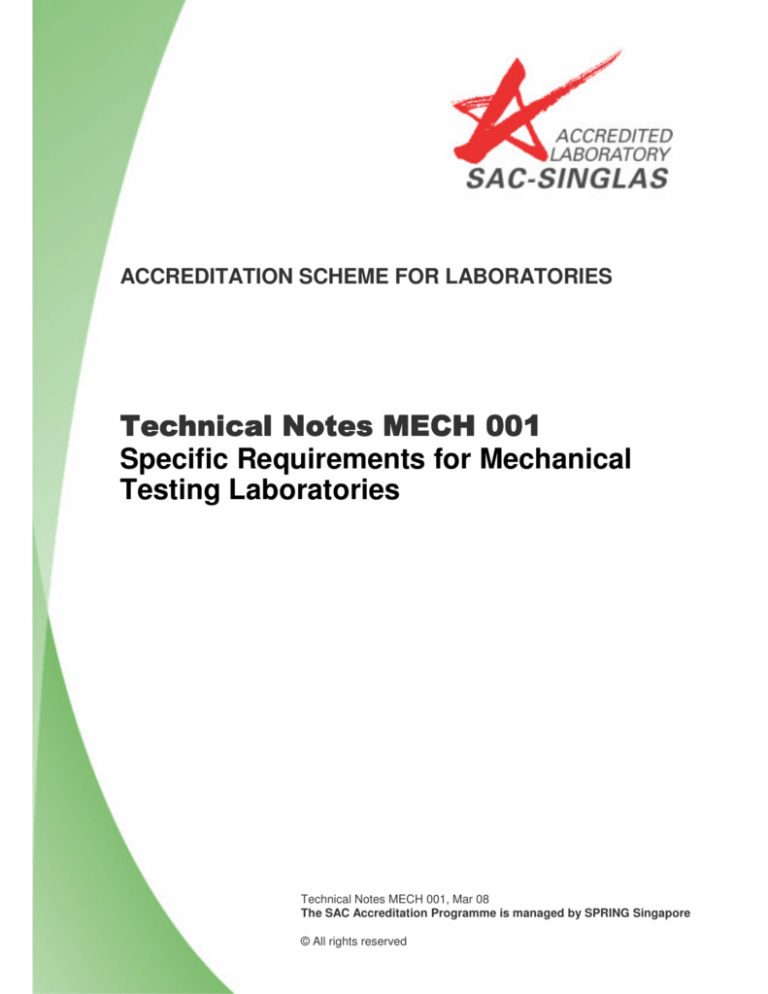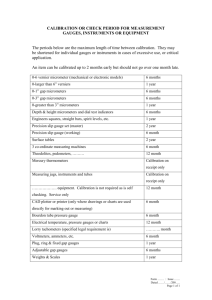
ACCREDITATION SCHEME FOR LABORATORIES
Specific Requirements for Mechanical
Testing Laboratories
Technical Notes MECH 001, Mar 08
The SAC Accreditation Programme is managed by SPRING Singapore
© All rights reserved
1.
1.1
Introduction
The field of Mechanical Testing covers a wide range of tests and is divided into
the following broad areas:
Tests on materials
Tests on products
Tests on assemblies, engineering plants and structures
Aerodynamic, hydraulic and pneumatic tests
Metallographic tests except chemical analysis
1.2
These Technical Note should be read in conjunction with documents SAC 01
"Terms and Conditions for Accreditation" and ISO/IEC 17025 "General
requirements for the competence of testing and calibration laboratories".
1.3
Supplementary information for specific areas of testing within the Mechanical
Testing field may be published as other Technical Notes.
2.
2.1
Testing Machines
All testing machines shall be of appropriate types for the particular tests to be
performed and each shall be of a suitable capacity. Where applicable, the
testing machine shall be capable of applying the required load at continuous
defined speeds until no greater load can be sustained.
2.2
The readability, accuracy and repeatability of testing machines shall comply
with the requirements of the appropriate standard for which accreditation is
sought.
3.
3.1
Calibration of Equipment
Table 1 in this document sets out the normal frequencies for calibrations and
performance checks of general equipment used in the field of Mechanical
Testing.
3.2
These frequencies are generally considered to be the minimum appropriate,
unless the other criteria specified below are met:
(a)
the equipment is of good quality and of proven stability, and
(b)
the laboratory has both the equipment capability, competent staff and
expertise to perform adequate internal checks, and
(c)
if any suspicion or indication of overloading or mishandling arises, the
equipment will be checked immediately and thereafter at fairly frequent
intervals until it can be shown that stability has not been impaired.
MECH 001, Mar 08
Page 1 of 10
3.3
Where the criteria in 3.2 cannot be met or the relevant test standards have
specified more stringent requirements, Table 1 or the more stringent
requirements, whichever is more stringent shall be adopted.
3.4
Submissions for extension of calibration intervals based on factors such as
history of stability, frequency of use, accuracy required and ability of staff to
perform regular checks may be considered. It is the responsibility of the testing
laboratory to provide evidence that its calibration system would ensure that
confidence in the equipment could be maintained.
3.5
Sensitive equipment such as balances, force, impact and hardness testing
machines shall be rechecked or recalibrated if they are moved.
4.
Requirements for Tests On Metals
4.1
Hardness Testing
4.1.1 The laboratory shall do a performance check on each day before each type of
hardness tests. Records of such check shall be documented.
4.1.2 The check shall be at forces similar to those involved in the tests to be
conducted. So far as is practicable the hardness values involved shall match
those involved. Laboratories shall have an adequate range of blocks to cover
the range of hardness and the forces normally encountered.
4.1.3 For Vickers and Rockwell hardness tests, laboratories may use uncalibrated
indenters provided those indenters have been checked by performance tests
on hardness blocks with assigned values and by inspection at a magnification
of at least 50x.
4.1.4 Hardness blocks with assigned values from established block manufacturers
(such as Vickers, Avery, Wilson and Yamamoto) shall be used for the yearly
partial calibration.
4.1.5 Test reports shall state the source of calibration blocks.
MECH 001, Mar 08
Page 2 of 10
TABLE 1
S/N
TYPE OF EQUIPMENT
RECOMMENDED EQUIPMENT CALIBRATION INTERVALS
1.
Accelerometers
FREQUENCY OF
CALIBRATION OR
CHECK
1 year
2.
Anemometers
1 year
3.
Balances
1 year
GENERAL PROCEDURES AND
COMMENTS
In addition:
i) * Each
weighing
i)
Zero check
Reference mass to be calibrated every
three years
ii)
ii)
One point check using
known mass close to
sample weight
For repeatability of reading, ten
weighing are made of mass having a
value close to the maximum load of
balance
* Monthly
iii) * Half yearly
4.
Barometers
3 months (single
point)
5.
Dial gauges
1 year
6.
Dies and cutters
(For preparation of test
specimens such as dumbbell
specimen)
MECH 001, Mar 08
PARAMETERS TO BE
CHECKED
iii) Repeatability, linearity
or accuracy
Telephone comparison with
meteorology department
Full dimensional check
whenever sharpen
Page 3 of 10
Frequent examination for damage
S/N
TYPE OF EQUIPMENT
7.
Environmental chambers
8.
Extensometers
a)
b)
c)
d)
Lever and mirror type
Micrometer screw type
Dial indicator type
Recording types with
electrical output
9.
Force Measuring Device
(proving ring, transducer or
load cell)
10.
Force Testing Machine
(Tension, Compression,
Universal)
PARAMETERS TO BE
FREQUENCY OF
CHECKED
CALIBRATION OR
CHECK
1 year
Temperature and humidity
variation
1 year
1 year
1 year
1 year
1 year
Type 1 – Mechanical Force
Measuring System
a) Dead weight
3 year
b) Knife edge, lever and
steelyard
1 year
c) Pendulum dynamometer
1 year
d) Elastic dynamometer (e.g.
spring, ring with dial gauge)
MECH 001, Mar 08
1 year
Page 4 of 10
GENERAL PROCEDURES AND
COMMENTS
S/N
TYPE OF EQUIPMENT
Type 2 – Hydraulic or
Pneumatic Force Measuring
Systems
FREQUENCY OF
CALIBRATION OR
CHECK
a) Mechanical system
incorporating a pneumatic
or a hydraulic link (e.g.
proportional cylinder)
1 year
b) Bourdon Tube or
diaphragm gauge
1 year
PARAMETERS TO BE
CHECKED
1 year
c) Bourdon Tube or
diaphragm gauge fitted with
a master gauge which can
be disconnected during
normal testing
d) Bourdon Tube or
diaphragm gauge use only
as a null detector for a
mechanical system
1 year
e) Bourdon tube with electrical 1 year
transducer
Type 3 – Electrical Force
Measuring System
MECH 001, Mar 08
1 year
Page 5 of 10
GENERAL PROCEDURES AND
COMMENTS
S/N
11.
12.
13.
TYPE OF EQUIPMENT
FREQUENCY OF
CALIBRATION OR
CHECK
Gauge Blocks
a) Reference standards
4 years
b) Working equipment
2 years
Hardness Testers for Metals
a) Brinell, Vickers and
Rockwell (including
portable machine)
* 1 year – Indirect
verification
For performance
check, refer to
clause 4.1.1
b) Portable Brinell
Microscopes
1 year (with
calibrated
graticule)
c) Diamond indenters
1 year (inspection)
Hardness Tester for Rubber,
Plastics and Ebonite
a) Dead weight tester for
rubber
b) Dead weight tester for
plastic
c) Meters (durometers) for
rubber
MECH 001, Mar 08
PARAMETERS TO BE
CHECKED
3 years
3 years
1 year
Frequent checks
by user on
reference hardness
blocks
Page 6 of 10
GENERAL PROCEDURES AND
COMMENTS
S/N
14.
15.
TYPE OF EQUIPMENT
Hygrometers and
Psychrometers
a) Assman hygrometers and
sling type hygrometers
5 years
b) Recorders
(accuracy of ± 1% RH)
2 years
c) Other recorder including
hair types
1 year
PARAMETERS TO BE
CHECKED
GENERAL PROCEDURES AND
COMMENTS
Impact Testing Machine
(Pendulum Testing)
a) Charpy Impact Tester
(Metals)
b) Izod and Universal Impact
Testers (Metals)
c) Charpy and Izod Impact
Testers (Plastics)
d) Notching tools
16.
FREQUENCY OF
CALIBRATION OR
CHECK
Linear Variable Differential
Transducers (LVDTS)
MECH 001, Mar 08
)
)
)
)
)
)
)
)
)
)
Frequent
inspection by
user
Annual visual check on
striker and anvil for wear
and tear
* 1 year –
Indirect
verification
Check regularly and whenever
reground
* Daily or whenever Check against length
standards
used
1 year complete
calibration
Page 7 of 10
S/N
17.
TYPE OF EQUIPMENT
Length Measuring Devices
FREQUENCY OF
CALIBRATION OR
CHECK
a) Steel Rule
Initial
5 years
(Reference)
b) Vernier calipers
1 year
* Routine checks
monthly or less
depending on
use
c) Micrometer
1 year
* Routine checks
monthly or less
depending on
use
18.
Manometers
1 year
19.
Orifice Plates
Initial
* 6 months
20.
Ovens
1 year
21.
Pressure and Vacuum Gauges
a) Working gauges subjected
to shock loading
MECH 001, Mar 08
PARAMETERS TO BE
CHECKED
Check anvil for flatness
Visual inspection for
damage, wear or
contamination
6 monthly or less
depending on use
Page 8 of 10
GENERAL PROCEDURES AND
COMMENTS
S/N
TYPE OF EQUIPMENT
FREQUENCY OF
CALIBRATION OR
CHECK
PARAMETERS TO BE
CHECKED
GENERAL PROCEDURES AND
COMMENTS
b) Working gauges not
subjected to shock loading
1 year
22.
Stop watches and clocks
* 3 months
Comparison against the Singapore
Standard Time over at least ten
minutes
23.
Strain Meters
* 6 months
Using stop watch
24.
Tachometers
1 year
25.
Thermohygrograph
1 year
26.
Thickness Gauges
1 year
27.
Thermometers
a) Liquid-in-glass
28.
2 years
* 1 year
b) Electronic
1 year
Thermocouples
Initial
* 6 month
MECH 001, Mar 08
Checks at ice-points and at
one point within the working
range
Replace or perform
inhomogeneity test
Page 9 of 10
Inhomogeneity Test
Use an oil bath with temperature set at
the working temperature. Immerse the
thermocouple at different depth by
moving it slowly while recording the
output. A sudden change at the output
indicates a change in the seebeck
S/N
TYPE OF EQUIPMENT
FREQUENCY OF
CALIBRATION OR
CHECK
PARAMETERS TO BE
CHECKED
GENERAL PROCEDURES AND
COMMENTS
coefficient in the wire. A high quality
wire will have the seebeck coefficient
almost the same anywhere along the
wire. The wire will then be considered
as homogeneous.
Reference:
Traceable Temperature, An Introduction
to the Temperature Measurement and
nd
Calibration, 2 edition by J.V. Nicholas
and D.R. White
Note:
1)
An * in the table denotes those equipment calibration that may be carried out by the staff of a laboratory if it is suitably
equipped and the staff competent to perform such calibrations / checks.
2)
Where calibrations have been performed by the staff of a laboratory, adequate records of these measurements shall be
maintained.
MECH 001, Mar 08
Page 10 of 10



